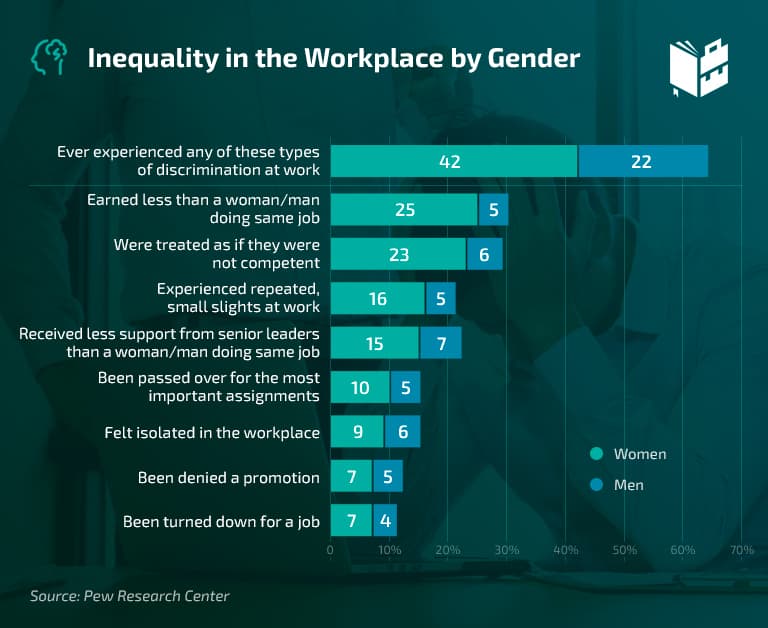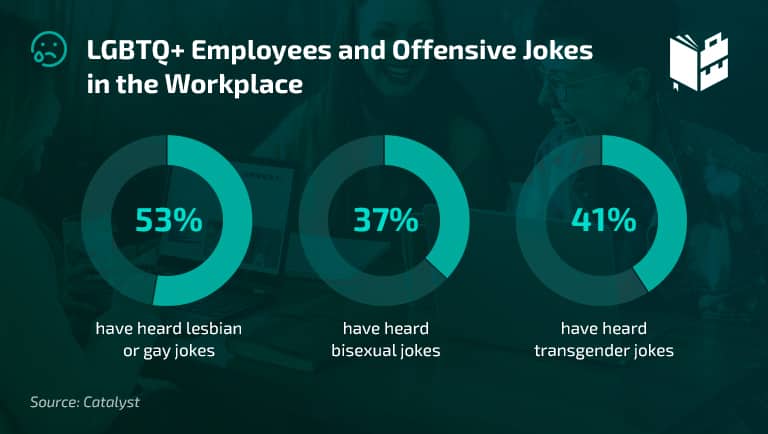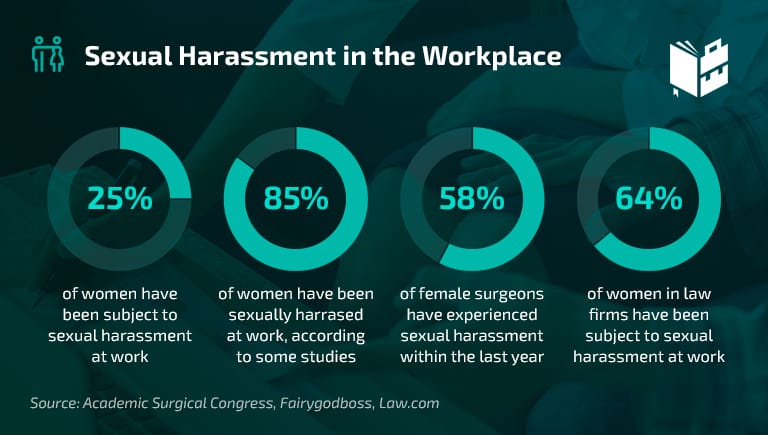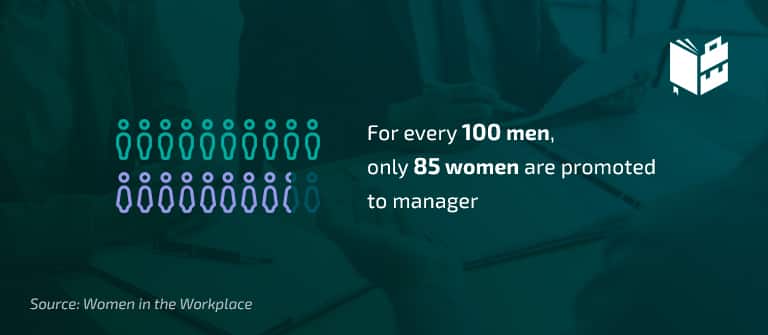Gender discrimination, sometimes called sex or gender bias, can be defined as unequal treatment of individuals based on their gender. Even though gender discrimination in the workplace statistics show that bias may come in various shapes and forms, women are discriminated against most of the time.
Examples of discrimination may vary from offensive jokes to sexual harassment. Such treatment is not only frowned upon, representing the violation of fundamental civil rights, but it’s also illegal. Still, it’s widespread and may even result in severe consequences, and medical conditions such as depression, anxiety, and even attempted suicide.
Top Sexism in the Workplace Statistics (Editor’s Choice)
- 42% of women have faced gender discrimination at work.
- Women earn 17.6% less than men.
- 23% of women are considered incompetent due to their gender.
- 67.5% of LGBTQ people endure offensive jokes at work.
- Women of color make up 31.3% of the low-wage labor force.
- Nearly 40% of economies around the world have laws preventing women from joining the workforce.
- 45% of women don’t have bodily autonomy.
- 51% of HR managers tend to be unintentionally gender-biased.
Gender Inequality in the Workplace Statistics You Didn’t Know
1. Women hold 6.4% of CEO positions at S&P 500 companies.
(Catalyst, BLS)
Women account for 47% of the entire US labor force. Still, the number is far too small regarding female CEOs at S&P 500 companies. As of 2022, there are 32 women CEOs, representing 6.4% of all S&P 500 CEOs.
2. Women make up 28.8% of the US Congress.
(FAS)
When it comes to state leadership, women represent a minority. Gender equality in the workplace statistics reveal there are 127 females in the House of Representatives, including three territorial delegates and the Resident Commissioner. Overall, there are 151 women in the entire 117th Congress. These figures also show that 24% of these women serve in the US Senate.
3. 42% of women have faced gender discrimination at work.
(Pew Research Center)
Nearly four out of 10 American women admitted they had experienced discrimination at work due to their gender, statistics on sexism show. The most frequent discrimination women reported included a range of incidents, from being paid less than male colleagues for the same job to being disregarded by managers for some important tasks.
Besides, 7% of working women reported that their managers refused to promote them, compared to 5% of men who encountered the same problem. As for gender bias in hiring statistics, 7% of women versus 4% of men didn’t get a job they applied for, even though they were equally qualified for the position.

4. 15% of female employees haven’t received enough support from their supervisors.
(Pew Research Center)
Manager’s support is more important than people may think. Unfortunately, not all employees get it. As you may guess, women are constantly denied support when they need it most.
Working women don’t have enough support from their managers or senior leaders, as sexism statistics show. More precisely, only 7% of men had such an experience. Also, one out of ten women stated that managers counted them out for some essential tasks, as opposed to 5% of men.
5. Women have 17.6% lower salaries than men.
(BLS)
The US Bureau of Labor Statistics reveals that women earn $943 weekly, while men earn $1,144. In other words, female workers with full-time employment make 82.4% of their male peers’ weekly earnings.
According to inequality in the workplace statistics, the women’s-to-men’s earnings ratio varies by race and ethnicity. Namely, white women earn 82.3% of their male counterparts. The percentages for Hispanic and Black women are 85.7% and 88.1%, respectively, whereas Asian women earn substantially less than Asian men (79%).
6. 25% of women have made less than men for the same job.
(Pew Research Center)
Possibly the biggest gender gap can be seen in remuneration. As reported by employment discrimination statistics, one out of four female employees (25%) admitted making less money than male employees for the same job.
For the sake of comparison, only 5% of men said they made less than their female colleagues. Even though the pay gap between men and women has narrowed since women became eligible to work, it still exists in spite of all the efforts and progress feminists have made.
Distressing Workplace Discrimination Statistics
7. 26% of workers in the UK feel they have been discriminated against because of their gender.
(SME Loans)
This percentage translates to 8.2 million employees in the UK. A survey shows that more men feel as if they’ve been victims of gender discrimination than women. Additionally, 24% of all the employees believe they didn’t get the job because of their gender.
8. 23% of women are more likely to be considered incompetent due to their gender.
(Pew Research Center)
Female workers are nearly four times as likely as their male colleagues to report being regarded as incompetent because of their gender. However, according to gender discrimination in the workplace statistics, only 6% of working men admitted they had received unfair treatment.
Similarly, 16% of working women said they repeatedly received minor insults in the workplace due to their gender. Those insults could be implicit, in the form of inadequate jokes or explicit comments directed at one’s gender, physical appearance, or sexual orientation. In contrast, only 5% of men encountered such unpleasantries.
9. 23.7% of LGBTQ community members face severe discrimination and hostility during job application.
(Williams Institute)
As for LGBT discrimination in the workplace statistics, almost a quarter of the LGBTQ Americans have encountered discrimination against their gender identity or sexual orientation when applying for a job. Needless to say, non-white LGBTQ community members are 29% more prone to this type of discrimination versus 18.3% of white LGBTQ Americans.
10. 67.5% of LGBTQ people hear offensive jokes at work.
(Williams Institute)
Offensive jokes based on an individual’s gender identity or sexual orientation are viewed as harassment. Judging from transgender discrimination in the workplace statistics, over two thirds of LGBTQ employees are victims of inappropriate jokes at work. Additionally, 57% reported discrimination on the grounds of religion.

Shocking Sexual Harassment in the Workplace Stats and Facts
11. At least 25% of women have been subject to sexual harassment.
(Academic Surgical Congress, Fairygodboss, IBA)
Sadly, discrimination isn’t limited only to unequal pay, lack of support, or offensive jokes in the workplace. It often goes even further, making women victims of something they have a hard time recovering from.
As indicated by sexual harassment in the workplace statistics, one-fourth of females have encountered sexual harassment at work. According to the Equal Employment Opportunity Commission’s research, that figure goes up to 85% in some instances.
However, not all industries are equally stricken. For example, recent studies have shown that 58% of female surgeons have experienced sexual harassment. Similarly, a third of females in law firms have been subject to this type of workplace discrimination.

12. More than seven in 10 workplace sexual harassment victims face retaliation.
(NWLC)
Workplace harassment statistics disclose that workers who report any mistreatment in the workplace encounter some sort of retaliation. Similarly, other studies indicate that numerous organizations fail to react to sexual harassment.
One study tells us many workplace sexual harassment victims face some form of retaliation — e.g., termination, being sued for defamation, and denial of promotions. Therefore, it’s no wonder many of them hesitate to report it.
13. Women are three times more likely to experience sexual harassment than men.
(Pew Research Center)
According to stats on sexism and a month-long study that included 4,914 adults, both men (35%) and women (36%) reported sexual harassment as a workplace problem. However, female employees are about three times as likely to experience it (22% of females as opposed to 7% of males).
Racial Discrimination in the Workplace Is Still Present
14. 90% of black women in the tech industry experience sexism at work.
(HBR)
A recent study has shown that only 3% of black knowledge workers want to return to the office once the pandemic is over. This particularly isn’t surprising when it comes to black women; sexism in the workplace statistics show that 90% say they experience different forms of sexism at work, while 81% say the same for racism.
Moreover, 79% have to change their appearance to better fit at work, and 95% say they need to prove themselves repeatedly to gain the recognition others automatically receive.
15. 47.2% of female Muslim workers have experienced religious discrimination and Islamophobia at work.
(The New Arab)
Recent data tell us that 84.2% of British Muslim women are engaged in the labor force. According to religious discrimination in the workplace statistics, nearly half of them face discrimination at work based on faith.
16. Women of color make up 31.3% of the low-wage labor force.
(National Women’s Law Center)
In fact, African-American women comprise 9.7% of the low-wage workforce. They are primarily involved in food service, housekeeping, retail, and other professions requiring no academic skills or professional training. Likewise, according to wage gap statistics, Hispanic females account for 16%, while Asian, Hawaiian, and Pacific Islander women make up 4.3% of the low-wage workforce.
17. Women of color accounted for only 11.3% of people in managerial positions in 2021.
(Catalyst, POCIT, US Department of Labor)
Racial discrimination in the workplace statistics show that non-white females frequently experience massive labor force gaps involving compensation and leadership positions. In S&P 500 companies, women of color comprise only 4% of board members.
African-American women with full-time employment make only 63 cents for each dollar white men earn. Latin American women make 55 cents, while Asian females earn 87 cents for each dollar white men make.
Stats and Facts About Gender Discrimination in the Workplace — Causes and Effects
18. Nearly 40% of economies around the world have laws inhibiting women from joining the workforce.
(The World Bank, UN)
Many countries across the globe have laws constraining women from both joining and remaining in the workforce. Additionally, husbands can legally prevent their wives from working in 18 countries worldwide. However, these laws vary by region.
Nevertheless, 87.5% of the South Asian countries have at least one legal limitation on women’s job prospects, the lack of sexual harassment legislation, criminal penalties, or civil remedies to protect women in the workplace. Female discrimination in the workplace statistics say the trends are the same in 83.7% of Europe and Central Asia, 80.7% of Sub-Saharan Africa, 78.1 % of Latin America, 69% of East Asia, and 62.5% of the Middle East and North Africa.
19. Over one million employment discrimination complaints have been filed since 2010.
(Washington Post)
Moreover, almost 930,000 complaints filed with the government were closed by January 2018. In 82% of cases, workers failed to get any form of relief. The typical outcome in two-thirds of closed cases was a “no cause” determination.
Despite the severe consequences it may have, discrimination at work is still taken lightly. Furthermore, the effects of gender inequality in the workplace may be detrimental to the victim. For example, it may lead to conflicts with colleagues or superiors and low productivity and morale. What’s more, it can even end in some legal issues.
More adverse effects may include deterioration of a victim’s overall health. Namely, bad treatment and discrimination may lead to depression, anxiety disorders, and even attempted suicide.
20. 129 million girls don’t attend primary school.
(UNICEF)
On a global scale, women don’t have equal schooling opportunities as men, which has a significant impact on their life careers. Global gender discrimination facts confirm that only 49% of countries have reached gender parity regarding primary education. On the other hand, the figure regarding lower secondary education is slightly lower (42%), while only 24% of countries have achieved gender parity in upper secondary education.
21. Over 1 billion women don’t have protection against violence.
(The World Bank)
Domestic sexual and economic abuse has a considerable impact on women’s ability to prosper. Yet, women’s equality in the workplace statistics disclose that almost 1.4 billion women don’t have any legal protection against domestic economic violence. Some countries even fail to protect women against harassment at work, school, home, or in public.
22. Only 26.1% of women sit in national parliaments.
(IPU)
It’s more than evident that women lack proper political representation. Although significant progress has been made over the years, women still don’t have adequate participation in parliaments.
According to gender discrimination statistics, the female presence in politics and governments is essential. Women raise questions about parental leave and childcare, gender equality legislation, pension, and gender-based violence that politicians neglect.
23. 45% of women don’t have bodily autonomy.
(UNFPA)
Sexual and reproductive health and rights have a direct bearing on the bodily autonomy and integrity of women. UNFPA’s latest report covering 57 countries reveals that barely half the women around the world have bodily autonomy — the right to decide on issues related to health care, contraception, and whether to have sex at all. Women discrimination facts and stats say that, in some countries, only one in 10 women are entitled to this right.
Another UNFPA report reveals that 40.9% of sexually active women don’t use contraception for several reasons. Apparently, not all women have the right to decide when they will give birth. According to the report, 48% of pregnancies worldwide are unplanned, 61% of which end in abortion.
Everyday Gender Discrimination in the Workplace Examples
24. Managers are twice as likely to hire a man.
(Built-In)
It’s no secret that most hiring managers are twice as likely to employ a male over a female worker. In addition, hiring stats argue that some of them intentionally reject women despite their qualifications and expertise, giving a chance to men who are less qualified and experienced than female candidates.
Sadly, job interviews aren’t the only instances that gender bias in the workplace statistics detect. In fact, gender discrimination is present in almost every segment of the business world. Rejections at job interviews are just a start. Other instances include lower payment, lack of support, and exclusion from important tasks. Without a doubt, the worst possible example is sexual harassment in the workplace that has the most detrimental effects on a victim.
25. 51% of HR managers tend to be unintentionally gender-biased.
(Built-In)
Statistics on discrimination in the workplace reveal that hiring managers subconsciously let gender bias influence their selection of candidates. Namely, over half of them choose an underperforming candidate just because of their gender. However, when the entire hiring team assesses a candidate, it chooses the most qualified one, regardless of gender.
26. For every 100 men, only 86 women are promoted to manager.
(McKinsey & Company)
Despite women’s progress in leadership, men still dominate leading positions. Interestingly, the gender gap for women of color has narrowed significantly at 85 women for every 100 men who were promoted, coming close to the overall number of women for the first time.

27. 60% of managers aren’t comfortable with working with or mentoring female co-workers.
(Survey Monkey)
Based on recent gender in the workplace statistics, nearly two-thirds of male managers or supervisors find it uncomfortable to mentor, socialize, or work one-on-one with their female colleagues. This might hurt women’s careers as the lack of mentorship might hinder their advancement. Similarly, 29% of male employees deem it wrong to go on business trips with junior women, compared to only 6% who claim the same regarding junior men.
28. Only 10% of female workers have a mentor.
(Built-In)
According to discrimination in the workplace statistics, 67% of women consider mentorship a crucial factor for their career advancement. Sadly, only a small number manages to get a mentor, although mentorship programs help companies increase retention rates for women by 15–38%.
Despite the significance of mentorship, female workers hardly obtain it. One of the reasons might be that male superiors or managers aren’t comfortable mentoring their female colleagues.
29. Just 54% of females consider mentorship.
(Built-In)
It seems that not many women succeed in becoming mentors. Gender differences in the workplace statistics suggest that the main factor dissuading them from mentoring is the time commitment. That’s the main reason three out of four working women refuse to mentor a junior colleague.
Another typical reason is self-confidence. Namely, many female employees doubt they have enough knowledge and expertise to be mentors. On the other hand, even 71% of them confirmed they would accept being mentors if asked.
30. The gender pay gap around the world ranges from 3% to 51%.
(International Labor Organization)
The history of gender inequality in the workplace reveals astonishing figures. Sexism and gender discrimination statistics claim that the average gender pay gap at a global level amounts to 17%.
When it comes to the US, pay equality has improved since 1979. At the time, female workers made 62% of their male colleagues’ salaries. During the 70s and 80s, female presence in the US workforce dropped, only to reach 60% at the beginning of the new millennium. In addition, women made 81% as much as men in 2010. Unfortunately, this number dropped again to 46.7% and has hardly risen so far.
Gender Discrimination in the Workplace Statistics — Conclusion
To sum up — women are victims of various forms of discrimination and harassment, even in the 21st century. Although it’s unlawful, gender discrimination continues to be one of the main issues in the workplace.
Some of the common consequences are anxiety, depression, and other mental health conditions. What’s more, it can even make a victim attempt suicide. Therefore, addressing such issues in the workplace must be every company’s priority to ensure a healthy working environment and make employees feel safe and become more productive.